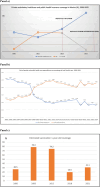Why expanding public health insurance coverage is not enough to provide effective ambulatory care: policy lessons from Mexico, 2000-2022
- PMID: 40442500
- PMCID: PMC12328214
- DOI: 10.1057/s41271-025-00564-y
Why expanding public health insurance coverage is not enough to provide effective ambulatory care: policy lessons from Mexico, 2000-2022
Abstract
Despite expanding public insurance coverage and investment in public healthcare supply, the Mexican population not covered by social security has increasingly used private-sector outpatient health services over the past two decades. This is a public health policy problem because Mexico is committed to a constitutional right to health protection, which means unmet ambulatory needs must be fulfilled. This brief aims to measure the magnitude of unmet ambulatory health care needs, analyze factors that led to their growth, and formulate policy options to address them. Private services' share of total ambulatory care grew from 38 percent in 2006 to 66 percent in 2022, despite two national policy efforts to increase public coverage to nearly 50 million people. Neither policy provided adequate ambulatory coverage for its targeted population, leading to care seeking through private outpatient providers. We recommend strengthening public ambulatory care by increasing financial resources for public primary care and implementing more effective allocation to improve timeliness and quality of care.
Keywords: Mexico; Outpatient health care; Policy lessons; Private use; Public health insurance.
© 2025. The Author(s).
Figures
Similar articles
-
Financial arrangements for health systems in low-income countries: an overview of systematic reviews.Cochrane Database Syst Rev. 2017 Sep 11;9(9):CD011084. doi: 10.1002/14651858.CD011084.pub2. Cochrane Database Syst Rev. 2017. PMID: 28891235 Free PMC article.
-
Inequities in the continuum of maternal care in Mexico: trends before and after COVID-19.Int J Equity Health. 2025 Jun 17;24(1):178. doi: 10.1186/s12939-025-02470-x. Int J Equity Health. 2025. PMID: 40528188 Free PMC article.
-
Signs and symptoms to determine if a patient presenting in primary care or hospital outpatient settings has COVID-19.Cochrane Database Syst Rev. 2022 May 20;5(5):CD013665. doi: 10.1002/14651858.CD013665.pub3. Cochrane Database Syst Rev. 2022. PMID: 35593186 Free PMC article.
-
Healthcare Costs for Diabetes Associated with Health Disparities in Puerto Rico.P R Health Sci J. 2025 Jun;44(2):95-98. P R Health Sci J. 2025. PMID: 40532056
-
[Volume and health outcomes: evidence from systematic reviews and from evaluation of Italian hospital data].Epidemiol Prev. 2013 Mar-Jun;37(2-3 Suppl 2):1-100. Epidemiol Prev. 2013. PMID: 23851286 Italian.
References
-
- Secretaría de Salud. Programa Sectorial de Salud, 2020–2024. Secretaría de Salud, Mexico. 2019. https://www.gob.mx/salud/documentos/programa-sectorial-de-salud-2020-2024. Accessed 14 Feb 2025.
-
- Reich M. Restructuring health reform, Mexican Style. Health Syst Reform. 2020;6(1): e1763114. 10.1080/23288604.2020.1763114. - PubMed
-
- Reyes-Morales H, Dreser-Mansilla A, Arredondo-López A, Bautista-Arredondo S, Ávila-Burgos L. Analysis and reflections on the 2019 initiative that reforms Mexico’s Ley General de Salud. Salud Publica Mex. 2019;61:685–91. 10.21149/10894. - PubMed
-
- Secretaría de Gobernación. Decreto por el que se crea el organismo público descentralizado denominado Servicios de Salud del Instituto Mexicano del Seguro Social para el Bienestar (IMSS–BIENESTAR). 2022. https://www.dof.gob.mx/nota_detalle.php?codigo=5663064&fecha=31/08/2022#.... Accessed 17 Jul 2024.
-
- Olaiz-Fernandez G, Rivera-Dommarco J, Shamah-Levy T, Rojas R, Villalpando-Hernandez S, Hernandez-Avila M, Sepulveda-Amor J. Encuesta Nacional de Salud y Nutricion 2006. Cuernavaca, Mexico: Instituto Nacional de Salud Publica; 2006.
MeSH terms
LinkOut - more resources
Full Text Sources
Medical
Miscellaneous

